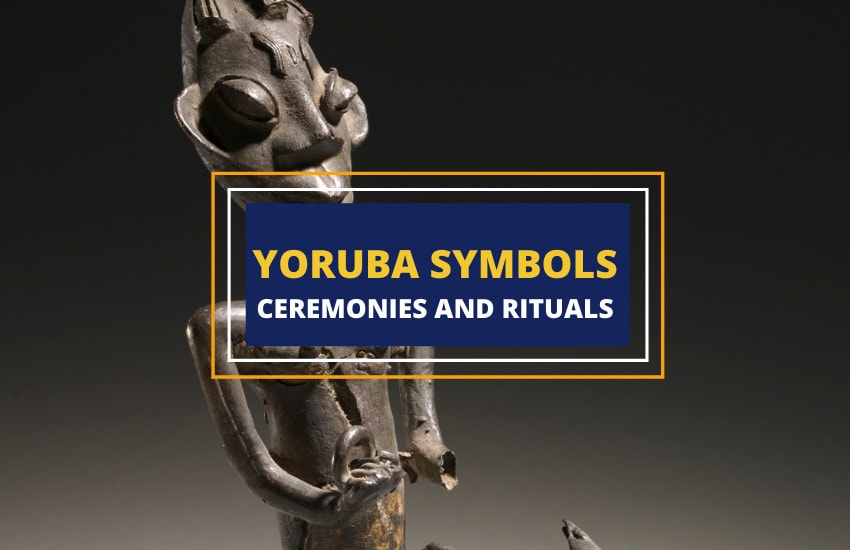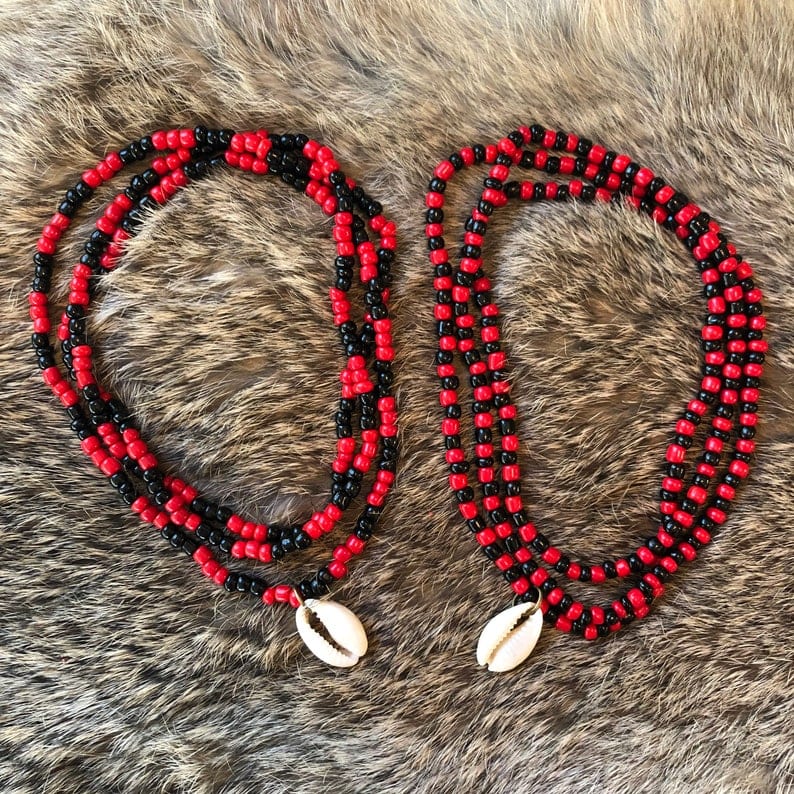
Table of Contents
Originated in West Africa, the Yoruba faith is a religion that combines animistic and monotheistic beliefs. This religion is widely practiced in modern-day Nigeria, Benin, and Togo, and it has also influenced several derived faiths in the Americas and the Caribbean.
Given the extent of the Yoruba religion’s sphere of influence, it’s symbolic and ceremonial features are becoming increasingly popular. Here’s the most popular Yoruba symbols, rituals, and ceremonies.
Receiving the Hand of Orula (Ceremony)
Traditionally, receiving the Hand of Orula is the first ceremony of initiation in the Yoruba religion. Orula (also known as Orunmila) is the god of knowledge and divination from the Yoruba pantheon. He is also regarded as the personification of fate.
During this ceremony, a priest uses divination to reveal to the person that is being initiated what his or her destiny on Earth is; the notion that everyone is born with a set of goals, sometimes even carried from past lives, is one of the fundamental beliefs from this religion.
Throughout this process, the initiation candidate also learns who his/her tutelary orisha is. Once this ceremony is done, the initiate can start wearing the green and yellow bead bracelet, which is a symbol of the protection that Orula keeps over the Yoruba practitioners.
In Cuba, the act of receiving the hand of Orula is called ‘Awofaka’, if the person that goes through the initiation is a man, and ‘Ikofa’, if it’s a woman. In both cases, this ceremony lasts for three days.
Receiving of the Necklaces (Ceremony)

Receiving the Necklaces, or elekes, is among the basic initiation ceremonies from the Lukumí religion, a Yoruba-based faith from Cuba.
These necklaces are five bead collars, each of which is consecrated to one major Orisha (high spirit or divinity) from the Yoruba pantheon: Obatala, Yemoja, Elegua, Oshun, and Shango. Except for Shango, who is considered a deified ancestor, all the other orishas are viewed as primordial divinities.
Before a person can go through the ceremony that would allow him or her to wear the necklaces, it is first necessary that a priest consults with the gods, through divination, if the candidate is ready for getting initiated. Once the permission is granted by the orishas, the making of the necklaces begins.
Since these necklaces are recipients of ashé (the divine energy that resides in all things, according to the Yoruba religion), only babalawos priests can assemble and deliver the elekes. The making of these collars consists of the collecting of the beads, which are chosen according to the colors associated with each of the aforementioned deities.
Once the beads are selected, the priest proceeds to assemble them using a cotton thread or a nylon. Then, the necklace is washed with aromatic essences, herbal infusions, and the blood of at least one sacrificial animal. The last element is the one that transmits the ashé to the necklace.
At the last part of the initiation ceremony, the body of the person being initiated is purified before receiving his or her collars. Those who had completed this initiation ceremony are known as aleyos.
The Washing of the Bonfim Stairs (Ritual)
The washing of the Bonfim stairs is a ritual of purification practiced within the Brazilian Candomblé celebration that holds the same name. Celebrated on the second Thursday of January, in the city of Salvador (the capital of the Brazilian state of Bahia), this festivity gathers hundreds of Camdomblé practitioners and tourists from different parts of the world.
During the first part of this ceremony, attendants gather at the Church of Conceição da Praia, to participate in an 8-kilometer procession that ends when the crowd arrives at the Church of Nosso Senhor do Bonfim.
Once there, the Bahianas, a group of Brazilian priestesses wearing only white (the color of Obatala, the Yoruba god of purity) start to wash the stairs of the church. Through this act, the Bahianas re-enact the washing of this temple done by African slaves, in the colonial times, during the preparations for the celebration of Epiphany Day.
During this ritual of purification, many people also received the blessings of the Bahianas.
Nosso Senhor do Bonfim (‘Our Lord of the Good End’) is the epithet assigned to Jesus Christ among Brazilians. However, in Candomblé, the figure of Jesus has been syncretized with that of the orisha Obatala. It is to this deity that the purification ritual practiced on this day is consecrated.
Twins (Symbol)
In the Yoruba religion, there are several beliefs associated with twins.
Usually called Ibeji, in honor of the twin gods from the Yoruba pantheon, twins tend to be regarded as a symbol of good fortune. However, this wasn’t always the case, as in ancient times, Yoruba people used to think that twins were born with preternatural powers, and therefore they could eventually become a threat to their communities.
Nowadays, if one of the twins dies, this is considered a sign of misfortune for the family or the community to which the deceased belonged. Therefore, to cast away all bad luck, the parents of the dead twin would commission a babalawo with the carving of an Ibeji sculpture. Honors and offerings are to be pledged to this idol.
Receiving of the Warriors (Ceremony)
This ceremony is usually conducted in parallel or right after receiving the hand of Orula. Receiving the warrior gods of the Yoruba pantheon means that these deities are going to guide and protect on the initiate from then on in his/her life.
At the beginning of this ceremony, a babalawo (who is also the godparent of the person being initiated) has to learn the path of each warrior god. This means that the priest determines, through divination, which characteristics of the personifications of the gods are to be delivered to the initiate. The character of these ‘avatars’ would vary depending on factors associated with the spiritual identity and the personality of the initiate.
The warrior orishas are given in this order: first Elegua, then Oggun, Ochosi and Osun.
Elegua, usually referred to as the ‘trickster’, is the god of beginnings and endings. He is also associated with the means of communication, as he is the messenger of Olodumare, the supreme Yoruba god. Oggun is the good of metals, of war, work, and sciences. Ochosi is the god of hunting, justice, skill, and intelligence. Osun is the guardian of the heads of every Yoruba believer and the deity of spiritual stability.
Among the elements that have to be brought for this ceremony are an Otá stone (an item that symbolizes the divine essence of the orishas), Orula powder, candles, Omiero (a purifying liquid made with curative herbs), brandy, sacrificial animals, the receptacle of the orishas, and its symbolic objects.
Elegua is given in the form of a hollow cement head, whose mouth, eyes, and nose are made of cowries. Oggun is represented by his seven metal work utensils, and Ochosi by his metal crossbow. The objects of the last two gods are to be kept in a black cauldron. Lastly, Osun is represented by a rooster figurine standing atop the cap of a metal cup.
During the ceremony to receive the four orisha warriors, the symbolic objects of each orisha must be ritualistically washed with Omiero. Afterwards, one animal sacrifice must be offered to each warrior god: a rooster for Elegua, and pigeons for each for Oggun, Ochosi, and Osun. Other secret ceremonial practices might be held as well, but they’re only revealed to the initiate.
Lastly, the highlight of the ceremony is when the person to whom the warriors will be handed kneels in front of his godparent, while the latter pours water over the head of the initiate and recites a prayer, in the traditional Yoruba language. After this, the initiate stands up to finally receive the warriors from his godparent.
Opon Ifá & Palm Nuts (Symbols)
An opon ifá is a divination tray used in the Yoruba religion for divinatory practices. As a symbol, the opon ifá is associated with Orula’s wisdom.
Orula is the god of knowledge and divination; some scholars have even considered the word ‘Ifá’ to be one of the appellatives given to Orula at Yorubaland in ancient times. However, nowadays, this term is more directly linked to the prime Yoruba divination system.
Divination is one of the fundamental precepts of the Yoruba religion. It’s practiced by babalawos, who, after being initiated, receive a pot containing several ritual items, among which are a set of palm nuts. Consecrated to Orula, it’s believed that these palm nuts are the embodiment of the god.
During a divination ceremony, a babalawo casts the palm nuts over the opon ifá, and then provides advice to the consultant, based on the combination formed by the consecrated nuts. In the Ifa system, there are at least 256 possible combinations, and the babalawo is expected to have memorized all of them by the time he starts to practice divination.
Batá Drums (Symbol)
Batá drumming is a fundamental part of the rituals of divination associated with the possessions of the body of a Lukumí practitioner by the spirit of an orisha.
According to oral tradition, the use of drums in Yoruba religious celebrations can be traced back to the 15th century, when the first drummer, called Ayan Agalu, was introduced to King Shango’s court, located in the mythical city of Ile-Ife.
Later on, Ayan Agalu himself was deified, and became known as ‘Añá’, the divinity that watches over all drummers and facilitates the communication between gods and mortals. Nowadays, it’s believed that the batá drums are a symbol of this orisha, as they are viewed as the vessels that transport Añá.
It’s worth noting that in the Yoruba religion, practitioners believe that most orishas have specific drumming rhythms, as well as songs and dances, which can be used to establish communication with them.
Nine-day Grieving Period (Ceremony)
In the Yoruba religion and throughout all its derived faiths, practitioners attend a nine-day grieving period after the death of a member of their community. During this time songs, prays and other signs of respect are offered to the deceased.
Conclusion
Despite having originated in West Africa, the Trans-Atlantic slave trade that took place during the Colonial Era spread the Yoruba religion in the Americas and the Caribbean. This contributed to the evolution of different types of Yoruba symbols, rituals, and ceremonies.
However, permeating all the three aforementioned elements of the Yoruba religion is the belief that there is a group of gods (the orishas) that can potentially intervene for the benefit of humans.








